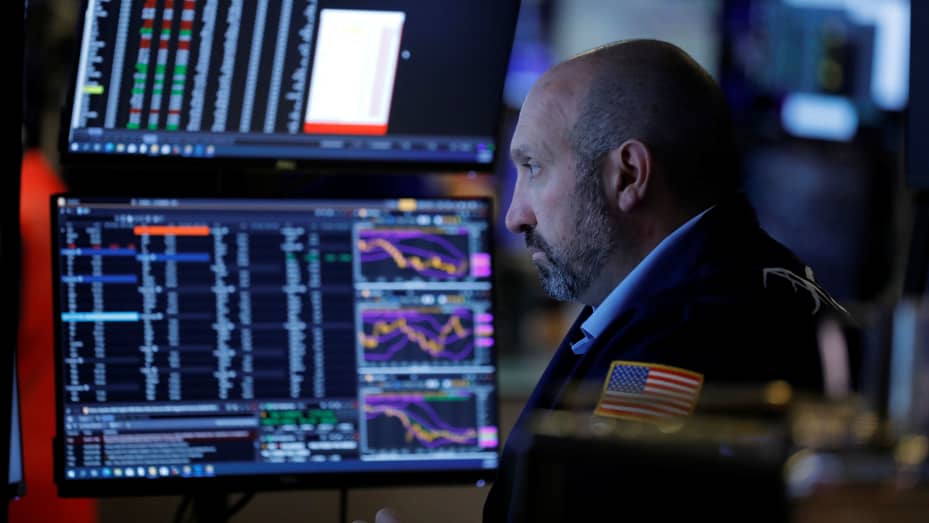Hannah Miao@HANNAHMIAO_

A trader works on the floor at the New York Stock Exchange (NYSE) in Manhattan, New York City, U.S., August 20, 2021.
Andrew Kelly | Reuters
U.S. stock futures began the week deeply in the red as investors continued to move to the sidelines in September amid several emerging risks for the market.
Futures on the Dow Jones Industrial average lost 535 points, or 1.6%. S&P 500 futures fell 1.3%. Nasdaq 100 futures dropped 1.1%.
There were a number of reasons for the sell-off:
Investors fear a contagion sweeping financial markets from the troubled China property market. Hong Kong equities saw a big sell-off during the Asia trading session on Monday. The benchmark Hang Seng index plunged 4% with embattled developer China Evergrande Group on the brink of default.
The Federal Reserve begins a two-day meeting Tuesday and investors are worried the central bank will signal it’s ready to start pulling away monetary stimulus amid surging inflation and improvement in the job market.
Covid cases because of the delta variant remain at January levels as colder weather approaches in North America.
September has the worst track record of any month, averaging a 0.4% decline, according to the Stock Trader’s Almanac. History shows the selling tends to pick up in the back half of the month.
Stocks linked to global growth were down the most in premarket trading Monday. Ford and Carrier Global lost more than 3%. General Motors and Boeing fell about 2% each. Nucor steel shed 2.8%
Energy stocks tumbled as WTI crude oil fell 2% on concerns about the global economy. Occidental Petroleum, Hess and Devon Energy were among the biggest losers in premarket trading.
Bond prices gained as investors sough safety. The move pushed the 10-year Treasury yield down by 4 basis points to 1.329%.
Big bank stocks took a hit as the falling rates may crimp profits. Bank of America and JPMorgan Chase were each down more than 2% in premarket trading.
“We think the mid-cycle transition will end with the rolling correction finally hitting the S&P 500,” wrote Mike Wilson, Morgan Stanley’s chief U.S. equity strategist. “We point to downside risk to earnings revisions, consumer confidence and PMIs.”
Wilson said he believes a “destructive outcome” is looking more likely that results in a pullback of 20% or more. On Friday, University of Michigan’s September consumer sentiment index came in at 71, just slightly above the August level that was the lowest in 9 years.
The Cboe Volatility index, Wall Street’s fear gauge, jumped above the 25 level on Monday, the highest since May.
Stocks have struggled so far in September in line with historical trends. For the month , the Dow is off 2.2%. The S&P 500 is lower by about 2% and the Nasdaq Composite is lower by 1.4%.
Friday the Dow Jones Industrial Average turned in three straight weeks of losses for the first time since September 2020. The Dow closed Friday’s regular session 166.44 points, or 0.5%, lower at 34,584.88. The S&P 500 shed 0.9% to 4,432.99 and the Nasdaq Composite lost 0.9% to close at 15,043.97.
The S&P 500 saw its biggest trading volume Friday since July 19, more than doubling its 30-day average volume. Friday coincided with the expiration of stock options, index options, stock futures and index futures — a quarterly event known as “quadruple witching.” History shows volatility tends to pick up around this event.
Stock picks and investing trends from CNBC Pro:
Fed Chair Jerome Powell will hold a press conference Wednesday at the conclusion of the two-day meeting. Powell has said the so-called tapering could occur this year, but investors are waiting for more specifics, particularly after mixed economic data released since Powell’s last comments.
Some investors believe this is just normal market action that can occur in September.
“Factors to build a ‘wall of worry’ are present (i.e., China, supply chain issues, Fed policy, debt ceiling, infrastructure/tax bill), though markets are not too disturbed for now. Normal pullbacks and volatility are to be expected, and we would use these periods as opportunities,” Raymond James Chief Investment Officer Larry Adam said in a note.
Other risky assets declined on Monday. Bitcoin lost 6%.
No comments:
Post a Comment